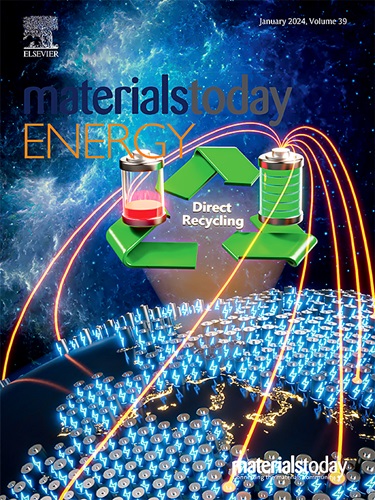Cobalt Nanoparticles Embedded in Nitrogen-doped Carbon Nanofibers to Enhance Redox Kinetics for Long-Cycling Sodium-Sulfur Batteries
IF 8.6
2区 材料科学
Q1 CHEMISTRY, PHYSICAL
引用次数: 0
Abstract
The shuttle effect resulting from severe volume expansion and polysulfide dissolution imposes limitations to the application of sodium-sulfur (Na-S) batteries. Herein, a three-dimensional self-supported electrode comprised of cobalt nanoparticles embedded in nitrogen-doped carbon nanofibers (CoNCNF) is constructed to accommodate sulfur as cathode for Na-S batteries. The carbon fiber framework facilitates direct electrons transmission and reduces overall contact impedance of electrode. The abundant pore structure not only promotes electrolyte infiltration but also ensures high loading of sulfur, and provides space for volume expansion during charging and discharging. Most significantly, CoNCNF carrier accelerate the conversion rate of sodium polysulfides (NaPSs) into NaS and guide NaS deposition on its surface in a three-dimensional progressive nucleation (3DP) mode, resulting in a high NaS deposition capacity and outstanding long-term cycling performance. When coupled with a Na metal anode, the CoNCNF/S composite cathode exhibits stable electrochemical properties with a capacity up to 1030.2 mA h g after 300 cycles at 0.2C and excellent rate performance.氮掺杂碳纳米纤维中嵌入钴纳米颗粒,提高长周期钠硫电池的氧化还原动力学性能
严重的体积膨胀和多硫化物溶解产生的穿梭效应限制了钠硫(Na-S)电池的应用。在此,我们构建了一种由嵌入氮掺杂碳纳米纤维(CoNCNF)的钴纳米颗粒组成的三维自支撑电极,可将硫作为钠硫电池的阴极。碳纤维框架有利于电子直接传输,并降低了电极的整体接触阻抗。丰富的孔隙结构不仅能促进电解质的渗透,还能确保硫的高负载量,并为充放电过程中的体积膨胀提供空间。最重要的是,CoNCNF 载体可加快多硫化钠(NaPSs)转化为 NaS 的速度,并以三维渐进成核(3DP)模式引导 NaS 在其表面沉积,因此具有很高的 NaS 沉积能力和出色的长期循环性能。当与 Na 金属阳极耦合时,CoNCNF/S 复合阴极表现出稳定的电化学特性,在 0.2C 下循环 300 次后,容量可达 1030.2 mA h g,并具有优异的速率性能。
本文章由计算机程序翻译,如有差异,请以英文原文为准。
求助全文
约1分钟内获得全文
求助全文
来源期刊

Materials Today Energy
Materials Science-Materials Science (miscellaneous)
CiteScore
15.10
自引率
7.50%
发文量
291
审稿时长
15 days
期刊介绍:
Materials Today Energy is a multi-disciplinary, rapid-publication journal focused on all aspects of materials for energy.
Materials Today Energy provides a forum for the discussion of high quality research that is helping define the inclusive, growing field of energy materials.
Part of the Materials Today family, Materials Today Energy offers authors rigorous peer review, rapid decisions, and high visibility. The editors welcome comprehensive articles, short communications and reviews on both theoretical and experimental work in relation to energy harvesting, conversion, storage and distribution, on topics including but not limited to:
-Solar energy conversion
-Hydrogen generation
-Photocatalysis
-Thermoelectric materials and devices
-Materials for nuclear energy applications
-Materials for Energy Storage
-Environment protection
-Sustainable and green materials
 求助内容:
求助内容: 应助结果提醒方式:
应助结果提醒方式:


